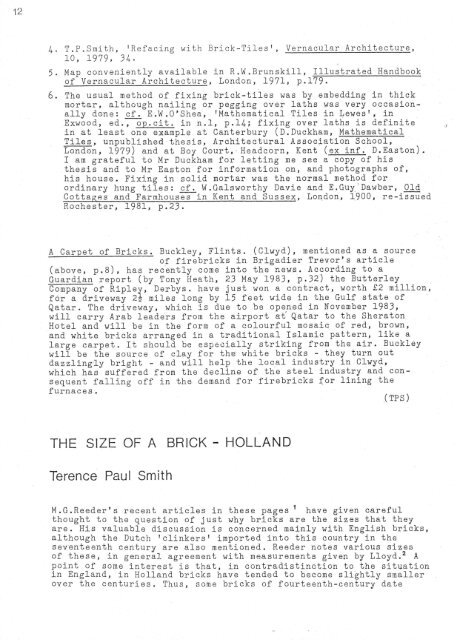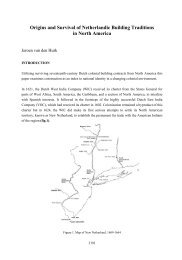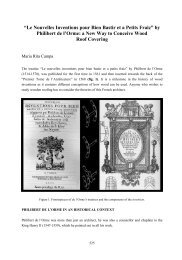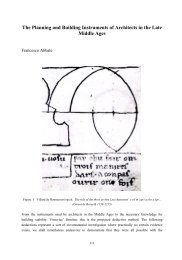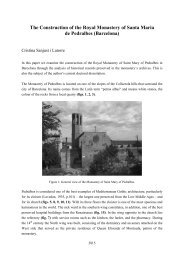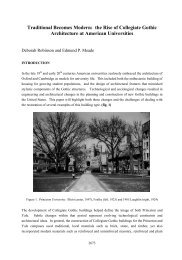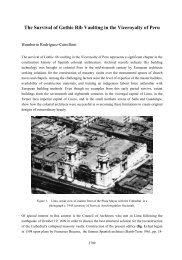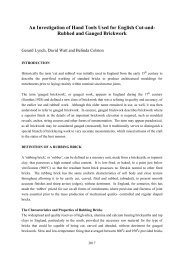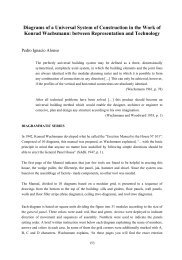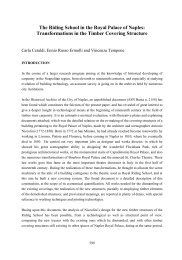bricks from the - Department of Architecture
bricks from the - Department of Architecture
bricks from the - Department of Architecture
Create successful ePaper yourself
Turn your PDF publications into a flip-book with our unique Google optimized e-Paper software.
12<br />
4. T.P.Smith, 'Refacing with Brick-Tiles', Vernacular <strong>Architecture</strong>,<br />
10, 1979, 34.<br />
5. Map conveniently available in R.W.Brunskill, Illustrated Handbook<br />
<strong>of</strong> Vernacular <strong>Architecture</strong>, London, 1971, p.179.<br />
6. The usual method <strong>of</strong> fixing brick-tiles was by embedding in thick<br />
mortar, although nailing or pegging over laths was very occasionally<br />
done: cf. E.W.O'Shea, 'Ma<strong>the</strong>matical Tiles in Lewes '<br />
, in .<br />
Exwood, ed.-:-Op.cit. in n.l, p.14; fixing over laths is definite<br />
in at least one example at Canterbury (D.Duckham, Ma<strong>the</strong>matical<br />
Tiles, unpublished<strong>the</strong>sis, Architectural Association School,<br />
London, 1979) and at Boy Court,' Headcorn, Kent (ex info D.Easton).<br />
I am grateful to MI' Duckharn for letting me see a copy cf his<br />
<strong>the</strong>sis and to MI' Easton for information on, and photographs <strong>of</strong>,<br />
his house. Fixing in solid mortar was <strong>the</strong> normal methodfot<br />
ordinary hung tiles: cf. W.Galsworthy Davie and E.Guy'Dawber, Old<br />
Cottages and Farmhouses in Kent and Sussex, London, 1900, re-issued<br />
Rochester, 1981, p.23.<br />
./<br />
A Carpet <strong>of</strong> Bricks. Buckley, Flints. (Clwyd), mentioned as a source<br />
<strong>of</strong> fire<strong>bricks</strong> in Brigadier Trevor's article<br />
(a~ove, p.8), has rec~ntly come into <strong>the</strong> news. According to a<br />
Guardian report (by Tony Heath, 23 May 1983, p.32) <strong>the</strong> Butterley<br />
Company <strong>of</strong> Riplei' Derbys. have just won a contract, worth £2 million,<br />
for a driveway 22 miles long by 15 feet wide in <strong>the</strong> Gulf state <strong>of</strong> .<br />
Qatar. The driveway, which is due to oe opened in November 1983,<br />
will carry Arab lead~rs <strong>from</strong> <strong>the</strong> airport a~ Qatar to <strong>the</strong> Sheraton<br />
Hotel and will be in <strong>the</strong> form <strong>of</strong> a colourful mosaic <strong>of</strong> red, brown,<br />
and white <strong>bricks</strong> arranged in a traditional Islamic pattern, like a<br />
large carpet. It should be especially striking <strong>from</strong> <strong>the</strong> air. Buckley<br />
will be <strong>the</strong> source <strong>of</strong> clay for tha white <strong>bricks</strong> - <strong>the</strong>y turn out<br />
dazzlingly bright - and will help <strong>the</strong> loeal industry in Clwyd,<br />
which has suffered <strong>from</strong> <strong>the</strong> decline <strong>of</strong> <strong>the</strong> steel industry and consequent<br />
falling <strong>of</strong>f in <strong>the</strong> demand for fire<strong>bricks</strong> ~or lining <strong>the</strong><br />
furnaces.<br />
(TPS)<br />
THE SIZE OF A BRICK - HOLLAND<br />
Terence<br />
Paul Smith<br />
M.G.Reeder's recent articles in <strong>the</strong>se pages 1 have given careful<br />
thought to <strong>the</strong> question <strong>of</strong> just why <strong>bricks</strong> are <strong>the</strong> sizes that <strong>the</strong>y<br />
are. His valuable discussion is concerned mainly with English <strong>bricks</strong>,<br />
although <strong>the</strong> Dutch 'clinkers' imported into this country in <strong>the</strong><br />
seventeenth century are also mentioned. Reeder notes various sizes<br />
<strong>of</strong> <strong>the</strong>se, in general agreement with measurements given by Lloyd. 2 A<br />
point <strong>of</strong> some interest is that, in contradistinction to <strong>the</strong> situation<br />
in England, in Holland <strong>bricks</strong> have tended to become slightly smaller<br />
over <strong>the</strong> centuries. Thus, some <strong>bricks</strong> <strong>of</strong> fourteenth-century date


